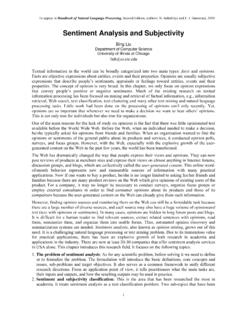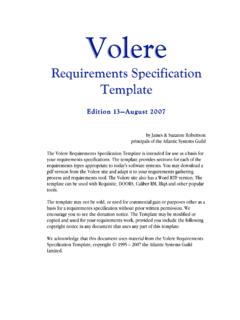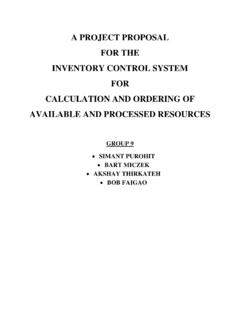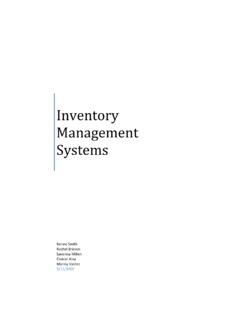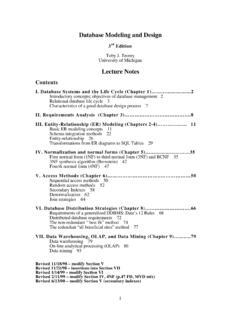Transcription of SYSTEM REQUIREMENTS SPECIFICATIONS FOR THE PROJECT …
1 SYSTEM REQUIREMENTS SPECIFICATIONS . FOR THE PROJECT . inventory CONTROL SYSTEM . FOR. CALCULATION AND ORDERING OF. AVAILABLE AND PROCESSED RESOURCES. GROUP 9. SIMANT PUROHIT. BARTLOMIEJ MICZEK. AKSHAY THIRKATEH. ROBERT FAIGAO. Page | 1. Executive Summary Our proposed PROJECT is a real time implementation of an inventory control SYSTEM for an on-site corporate restaurant management and catering company. One such company is Guckenheimer ( ) which builds, staffs, and upkeeps corporate kitchens as well as provides catering services to corporate companies. This PROJECT is specific in that it applies to the dining domain of restaurants, but is flexible enough to be applied to many different kitchens and restaurants. In the case of Guckenheimer, they can use the software in their kitchens across the nation. The scope of this PROJECT will primarily focus on Guckenheimer s kitchen and inventory located at the Groupon Chicago Office.
2 Currently at Groupons kitchen, and the food industry in general, restaurant staff and managers are forced to keep track of inventory by hand. This means that they must count what they have sold and what they have left at the end of each day. They must also fill out order forms to be sent to vendors so that they can restock their inventory in preparation for the next week. This wastes valuable man hours and is a rather simple task to automate using our software. We propose a solution to this issue by developing software that keeps track of inventory in the back of house , or kitchen, and updates it according to daily sales. Each food item is linked to respective resources (or ingredients) and as each product is sold the ingredients utilized in making that product are also utilized. These changes in inventory are kept track of through utilizing a database .
3 We propose to keep track of each and every ingredient by dynamically linking it to the product and as a result create a dependent relationship to that product. At a specific time period (typically the end of the week); if the inventory is below the threshold level, order forms to the specific vendors are generated in order to restock the required items for the next week. The PROJECT also makes smart predictions on required inventory for the following week based upon the predicted climate and possible occasions or events that may influence near future sales. At the end of the week, the software takes into account all threshold levels, predictions, and other factors to generate an order form, which after being verified by the manager is sent out to the vendors. Page | 2. INDEX. 1. Introduction Purpose of the SYSTEM .. 4. Scope of the SYSTEM .
4 4. Objectives and success criteria of the PROJECT . 5. The Domain of the PROJECT .. 5. The Client . 6. The User .. 6. Definitions, acronyms, and abbreviations .. 7. 2. Current SYSTEM 8. 3. Proposed SYSTEM Overview 8. Functional REQUIREMENTS .. 9. Nonfunctional REQUIREMENTS Usability 9. Reliability . 9. Performance .. 10. Supportability .. 10. Packaging .. 10. Implementation 10. Interface 11. Legal 11. SYSTEM models Scenarios .. 12. Use case model 19. Object model Generalization and Class Hierarchy Diagram . 41. Multiplicity Diagram . 42. Association Diagram 43. Dynamic model (Sequence Diagrams) 44. User interface navigational paths and screen mock-ups .. 50. Architecture Breakdown . 56. 4. Glossary 58. Page | 3. 1. Introduction Purpose of the SYSTEM A case study at Guckenheimer (an on-site corporate restaurant management and catering company) cited issues regarding a basic resources requirement list that has to be maintained manually by the staff.
5 To keep track of their inventory levels they have to calculate a list of the groceries utilized during a course of time, calculate and analyze the REQUIREMENTS for the future, and place their next order to the vendors if needed. This process takes up a lot of time and human effort, and is also prone to human error. This poses a problem of a situation that the staff at Guckenheimer, as well as many other restaurants faces. It takes up a lot of time to manually keep track of sales and place correct orders to vendors, wasting useful labor in trivial works. A product which would assist in tackling the above mentioned problems would prove to be fruitful to clients such as Guckenheimer and similar enterprises as this product would help convert the unproductive time to something more useful, by removing the unnecessary error prone complications and efforts.
6 Scope of the SYSTEM The PROJECT aims at providing an efficient interface to the restaurants for managing their grocery inventory based on each item sold. The basic idea involved here is that each item is linked to its atomic ingredients which are stored in a database . At the end of each day, the SYSTEM analyzes the total sale of menu items and proportionately deducts appropriate amount from the resource database . Then it compares the current available resources with the threshold level of each ingredient. If it finds that certain ingredients are below the threshold, it will generate a purchase order for those item(s) and send it to the manager (admin) for approval. We also propose to include a special feature Prediction . This feature keeps track of any upcoming occasions, climatic changes and special events that may influence inventory needs for the upcoming week.
7 The SYSTEM will then predict the required resources for these events based on previously accumulated information/knowledge. It will now generate an updated purchase order in accordance with the predictions. The product also aims to keep track of the shelf life of resources. If any resource nears the end of its shelf life, it would intimate to the manager (admin) the details of the quantity that is near its expiration date. The restaurant must function efficiently, the groceries must be tracked correctly, timely orders must be sent out to the vendors, and the inventory must be maintained and updated at all times. Page | 4. Objectives and success criteria of the PROJECT The objective of the PROJECT is to provide an efficient inventory control whose main functionality apart from calculating the inventory include predicting the requirement for the next order and also if there is a Special Occasion then accordingly the manager selects the particular occasion and extra REQUIREMENTS is added to the next issuing order to the vendors which needs to be approved by the manager.
8 The product also aims to keep track of the shelf life of resources. If any resource nears the end of its shelf life, it would intimate to the manager (admin) the details of the quantity that is near its expiration date. The success criteria depends on The accuracy in maintaining the inventory levels The accuracy in predicting the REQUIREMENTS of the next order The accuracy in relating recipes to their respective ingredients Ease of use when it comes to updating inventory levels and placing orders to vendors The Domain This proposed PROJECT aims at inventory control in the restaurant and catering Industry. Such a large domain would result in an equally as large scope of development. As a result we narrow our software down to our case study of an outlet of Guckenheimer concentrating only on the basic resources utilized in inventory control of the outlet.
9 Although the software will be developed keeping in mind the needs of Guckenheimer and available data at first, then applying it to the larger domain of the entire restaurant industry can be achieved with ease. Our target domain is full of software to track sales of food items, but lacks in this area of inventory management. Our software can be scaled from large corporate dining all the way to small privately-owned restaurants. It is also fairly domain specific: the database runs off recipes which generate the necessary ingredients. It also updates the inventory based off of the sale of those recipes. This requirement focuses our product to our domain and makes it more appealing to those looking for a solution to this specific problem. Page | 5. The Client The client can vary from private restaurant owners to corporate restaurant management companies, such as Guckenheimer ( ).
10 A corporate restaurant management company that starts up, staffs, and oversees the everyday workings of a corporate restaurant, such as the one in the Groupon Chicago office. As stated above, while our product can be applied to the entire domain of the restaurant and catering business, focusing on a specific business provides us with more precise and consistent data. A company such as Guckenheimer would be an ideal client, as they staff multiple corporate kitchens across the nation, including kitchens for Groupon and even Google. A large scale company such as this this can apply our software to each and every kitchen, cutting down costs on a very large scale. Our software will allow our client to customize the database to suit the needs of each kitchen individually. They can vary in recipes, vendors from which they order their products, and threshold levels.








